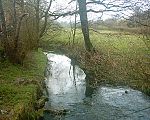Tinsley Viaduct
1968 establishments in EnglandBridges completed in 1968Bridges in SheffieldBridges over the River Don, South YorkshireDouble-decker bridges ... and 8 more
M1 motorwayMotorway bridges in EnglandPages containing links to subscription-only contentRoad transport in SheffieldSteel bridges in the United KingdomSubscription required using viaUse British English from September 2017Viaducts in England

Tinsley Viaduct is a two-tier road bridge in Sheffield, England; it was the first of its kind in the United Kingdom. It carries the M1 and the A631 for a distance of 3,389 feet (1,033 m) over the Don Valley, from Tinsley to Wincobank, also crossing the Sheffield Canal, the Midland Main Line and the former South Yorkshire Railway line from Tinsley Junction to Rotherham Central. The Supertram route to Meadowhall runs below part of the viaduct on the trackbed of the South Yorkshire Railway line to Barnsley.
Excerpt from the Wikipedia article Tinsley Viaduct (License: CC BY-SA 3.0, Authors, Images).Tinsley Viaduct
Tinsley Viaduct, Sheffield Tinsley
Geographical coordinates (GPS) Address Nearby Places Show on map
Geographical coordinates (GPS)
| Latitude | Longitude |
|---|---|
| N 53.4175 ° | E -1.4058333333333 ° |
Address
Tinsley Viaduct
Tinsley Viaduct
S9 1RD Sheffield, Tinsley
England, United Kingdom
Open on Google Maps









